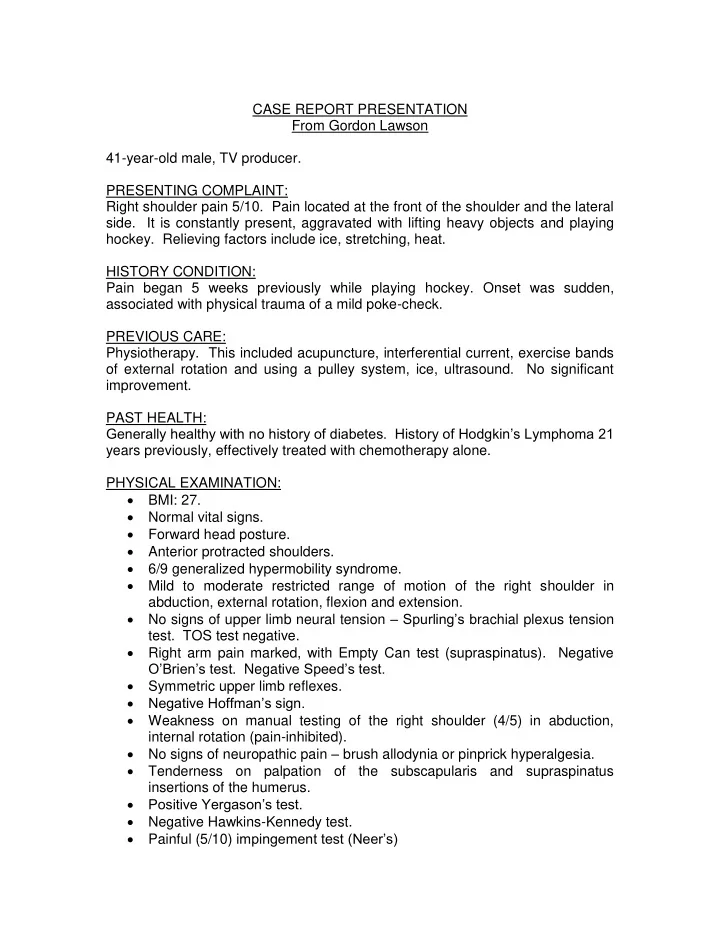

CASE REPORT PRESENTATION From Gordon Lawson 41-year-old male, TV producer. PRESENTING COMPLAINT: Right shoulder pain 5/10. Pain located at the front of the shoulder and the lateral side. It is constantly present, aggravated with lifting heavy objects and playing hockey. Relieving factors include ice, stretching, heat. HISTORY CONDITION: Pain began 5 weeks previously while playing hockey. Onset was sudden, associated with physical trauma of a mild poke-check. PREVIOUS CARE: Physiotherapy. This included acupuncture, interferential current, exercise bands of external rotation and using a pulley system, ice, ultrasound. No significant improvement. PAST HEALTH: Generally healthy with no history of diabetes. History of Hodgkin’s Lymphoma 21 years previously, effectively treated with chemotherapy alone. PHYSICAL EXAMINATION: BMI: 27. Normal vital signs. Forward head posture. Anterior protracted shoulders. 6/9 generalized hypermobility syndrome. Mild to moderate restricted range of motion of the right shoulder in abduction, external rotation, flexion and extension. No signs of upper limb neural tension – Spurling’s b rachial plexus tension test. TOS test negative. Right arm pain marked, with Empty Can test (supraspinatus). Negative O’Brien’s test . Nega tive Speed’s test. Symmetric upper limb reflexes. Negative Hoffman’s sign. Weakness on manual testing of the right shoulder (4/5) in abduction, internal rotation (pain-inhibited). No signs of neuropathic pain – brush allodynia or pinprick hyperalgesia. Tenderness on palpation of the subscapularis and supraspinatus insertions of the humerus. Positive Yergason’s test. Negative Hawkins-Kennedy test. Painful (5/10) i mpingement test (Neer’s)
DIAGNOSTIC IMAGING: Sonogram of the right shoulder revealed: 1. Right supraspinatus and subscapularis tendinosis with a full-thickness partial-width tear in inferior fibers of the subscapularis tendon and a partial-thickness articular surface tear in the supraspinatus tendon. 2. Medial subluxation of the long head of the right biceps tendon likely due to the above-described subscapularis tendon tear. 3. Mild right subdeltoid bursitis. 4. Sonographic signs of grade 2 right supraspinatus impingement. 5. Probable and ununited fracture of the inferior edge of the right glenoid. DIAGNOSIS: 1. Right supraspinatus and subscapularis tendinosis with full-thickness partial-width tear. 2. Right shoulder impingement syndrome. 3. Propensity towards ligamentous laxity hypermobility syndrome. PLAN OF MANAGEMENT: 1. Platelet Rich Plasma injections and rehabilitation. Platelet Rich Plasma injections into the right supraspinatus insertion, infraspinatus insertion, subscapularis insertion, biceps femoris and the subacromial joint space. 2. Basic sling advised to be worn for the first 72 hours, with reduced activity until follow-up examination. FOLLOW UP ASSESS 6 WEEKS POST PRP Right shoulder 80% improved. Feels more stable, less clicking. Pain more localized into the anterior region. Feels some stiffness and a dull ache if over-exerting area. OBSERVATION/EXAMINATION: 1. Slight weakness (4/5) of the supraspinatus and infraspinatus. 2. Moderate tenderness over the acromioclavicular joint and subscapularis insertion. Recommendation of a follow-up Platelet Rich Plasma injection. 3. 6-week post-examination follow-up: improved, slight pain on forward flexion and external rotation and inferior pulling. 4. Very little tenderness, still slight weakness in the rotator cuff muscles. RECOMMENDATIONS: 1. Increase rehabilitation and strengthening, particularly the supraspinatus, subscapularis, infraspinatus and biceps.
FOLLOW-UP 13 WEEKS POST Return to normal strength. Very little tenderness. Resolution of symptoms. Return to hockey and full function.
Recommend
More recommend